Keywords
|
| Biometrics, Iris Authentication, Wavelet Transform, Feature extraction. |
INTRODUCTION
|
| Automated personal recognition based on iris is considered one of the most reliable techniques among facial thermogram, hand vein, gait, keystroke, odour, ear, hand geometry, fingerprint, face, retina, palm print, voice and signature. Iris lies between the cornea and the lens of the human eye as shown in Fig. 1 [13]. Iris is perforated close to its centre by a circular aperture known as the pupil. Iris patterns are highly distinguishing to an individual which are distinct even between the identical twins and between the left and right eyes of a person and can be seen from some distance [1]. |
| Iris recognition problem can be classified into two categories: identification and authentication. Identification involves a one to many comparisons whereas authentication involves one to one comparison of the extracted features of input iris image with stored templates. A variety of iris recognition methods have been recommended for automatic personal identification and authentication. There are four phases in iris recognition system: segmentation, normalization, feature extraction, and matching. Feature extraction is considered a vital step in iris recognition. There is an argument to build up an iris recognition system by using appropriate feature extraction technique with reduced size of template features as well as computational time and simultaneously without compromising the accuracy. |
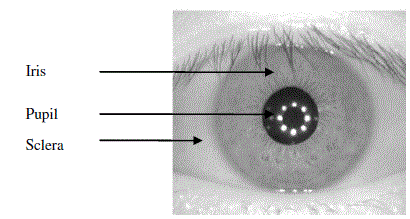
Fig. 1 Typical eye image [13] |
| Different approaches advised by researchers to extract iris features. Daugman developed first iris recognition system and used two dimensional Gabor filter for feature extraction [1]. Alternative approach based on wavelet transform to extract iris features is suggested by various researchers. Jaemin Kim et al. proposed a method to extract features of iris image using a continuous wavelet transform that is translation invariant and robust to noises [2]. To reduce the computational cost Xiaofu He et al. recommended iris feature extraction method based on the Complex Wavelet Transform [4]. |
| Different wavelets Haar, Daubechies, Coiflet, Symlet and Biorthogonal were employed to extract the features of iris image [5]. Complex Wavelet Transform [6], [12], Dyadic wavelet transform [3], Daubechies D4 wavelet [9], and Discrete wavelet transform [7], [25] is exploited to extract the feature of normalized iris image. Lin Zhonghua et al. proposed iris recognition method based on the Morlet wavelet transform real coefficients to improve the recognition speed [8]. Mohammed A. M. Abdullah et al. applied Haar wavelet and generated reduced template feature vector by concatenating LH4, HL4, LH5, HL5, and HH5.coefficients [10]. Ayra G. Panganiban et al. also performed feature encoding by decomposing the normalized iris image using Haar and Biorthogonal wavelet families at various levels [11]. |
| The remaining sections are organized as following: Proposed iris authentication system is contended in section 2. Section 3 shows experimental results and discussion. Finally section 4 concludes the paper. |
PROPOSED SYSTEM
|
| In this work CASIA V3.0 iris database is utilized, which is provided from the National Laboratory of Pattern Recognition (NLPR) in China. CASIA V3.0 Lamp iris database comprises of 756 grayscale eye images with 108 eyes and 7 different images of each unique eye, captured in two sessions. The size of eye images in this database is 320×280. |
| Iris authentication system has been implemented using MATLAB because of powerful inbuilt mathematical and image processing functions. An iris authentication system can be decomposed into four modules: segmentation, normalization, feature extraction and matching. |
| A. Segmentation |
| An eye image contains iris as an annular part between the pupil and the sclera which can approximately be taken as circles. There are also other parts of the eye such as the eyelid, the eyelash which makes accurate recognition procedure difficult. For the purpose of accuracy it is required to separate the actual iris region in an eye image. Circular Hough transform is applied for localising the iris and pupil regions. Linear Hough transform is exploited for localising occluding eyelids and thresholding for isolating eyelashes and reflections. Iris/sclera boundary was isolated first in order to make circle detection faster. After finding iris /sclera boundary, iris/pupil boundary is separated. Finally, eyelids were detached by fitting a line to eyelids by means of Linear Hough transform [15], [16]. Segmented iris image is shown in Fig. 2. |
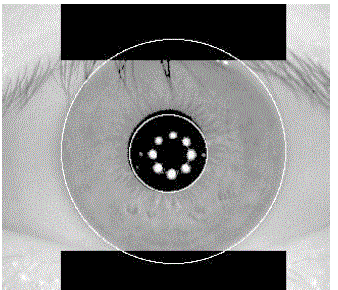
Fig. 2 Segmented iris |
| B. Normalization |

Fig. 3 Daugman’s rubber sheet model [1] |
| Because of disparity in light, pupil size, and distance of the eye from the camera, the size of the iris for the same person may vary. Iris matching results can be influenced by these aspects. In order to get accurate results, it is necessary to eliminate these factors. Therefore, once iris is located, it is needed to adjust each iris image to the similar dimension through normalization. |
| Normalized representation of iris region with constant dimensions is constructed by using Daugman’s rubber sheet model [1] as shown in Fig. 3. Points within the iris region are remapped to a pair of polar coordinates (r, θ) where r is on the interval [0, 1] and θ is angle [0,2π] as shown in Fig. 3. |
| The remapping of the iris region from Cartesian coordinates (x, y) to polar coordinates is carried out as follows: |
 |
| where I(x, y) is the iris region image, (x, y) are the original Cartesian coordinates, (r, θ) are the corresponding normalized polar coordinates, and xp , yp and xi , yi are the coordinates of the pupil and iris boundaries along the ‘θ’ direction [2]. Normalized iris image after applying Daugman’s rubber sheet model on segmented iris image is shown in Fig. 4. |
 |
| C. Feature Extraction |
| Feature extraction is vital process because people are authenticated based on these characteristics features. Feature extraction is carried out using wavelet transforms. Iris image is decomposed into four coefficients HH, LH, HL and LL at each level. Here ‘H’ and ‘L’ mean the high pass and low pass filters respectively. Normalized iris image is decomposed into a maximum of four levels to create the feature vectors. HH4 coefficients provide approximately analogous information as HH1, HH2, and HH3 coefficients. LH4 and HL4 also provide patterns similar to the preceding coefficients. In order to create feature vector LH4 and HL4 are combined. Here, Haar, Daubechies, Symlet and Reverse Biorthogonal wavelets are employed for feature extraction. Decomposed normalized iris image using db10 wavelet at level 4 is shown in Fig. 5. |
 |
| Two levels quantization scheme is applied to encode integer valued feature vector into bitwise feature vector. The coefficients greater than or equal to 0 are assigned value 1 and coefficients less than 0 are assigned value 0 [1]. |
| D. Matching |
| The last phase of the iris authentication system is the feature vector matching. The matching of feature vector is employed using the Hamming distance [1]. For comparing the feature vectors Sj and Tj, the HD (Hamming Distance) is defined as the sum of differing bits over N, the total number of bits in the feature vector. |
 |
RESULTS AND DISCUSSION
|
| This section provides performance measures, database used, and experimental results of iris authentication system. In an authentication system, performance can be evaluated in terms of three different error rates: FAR, FRR, and ERR. FAR (False Acceptance Rate) measures the probability of unauthorized user being accepted by the system. FRR (False Rejection Rate) FRR measures the probability of an authorized user being rejected by the system. ERR (Equal Error Rate) is the value where FAR and FRR rates are equal. |
| A. Experiment 1 |
| In first experiment single eye image of 200 users are taken from CASIA Iris V3.0 Lamp in order to identify optimal performance of wavelet from each family. Same eye image is employed for enrolment and for testing. Through the range of hamming distance values, the threshold values of Haar, Daubechies, Symlet and Reverse Biorthogonal families are identified. Most efficient wavelet, from all wavelet families in terms of % FAR at different hamming distance values are shown in Table I. |
| Haar wavelet with 0.36 threshold value provides minimum FAR=1.52 % as shown in. In symlet wavelet family sym10 offers minimum FAR=0% for the threshold values between 0 and 0.42. Best performance FAR= 0% in Daubechies wavelet family is provided by db10 between 0 and 0.39 threshold values. In reverse biorthogonal family, rbio5.5 furnishes minimum FAR=0% at 0.36 threshold values. % FAR at different hamming distance values is shown in the following Figures 6 through 9. Haar wavelet compare to symlet, daubechies and reverse biorthogonal gives largest % FAR for all hamming distances. |
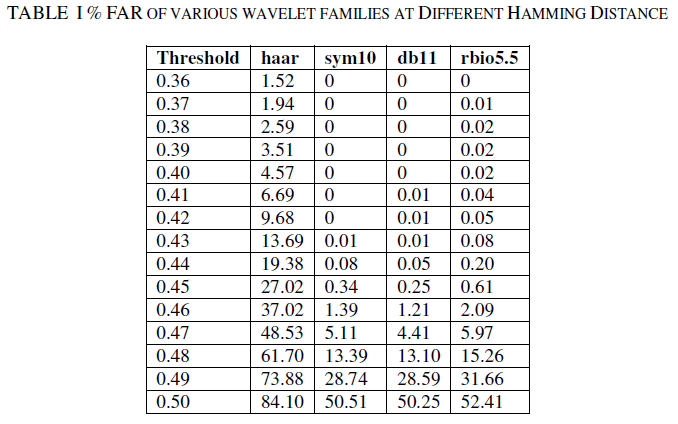 |
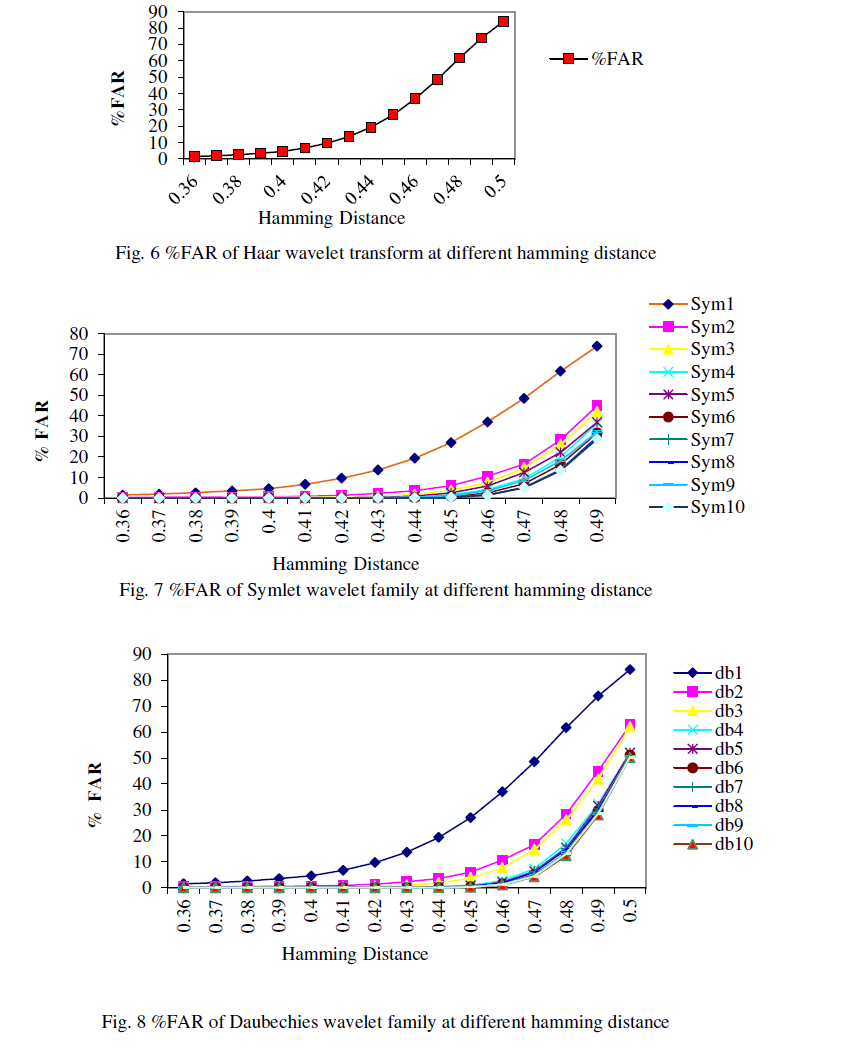 |
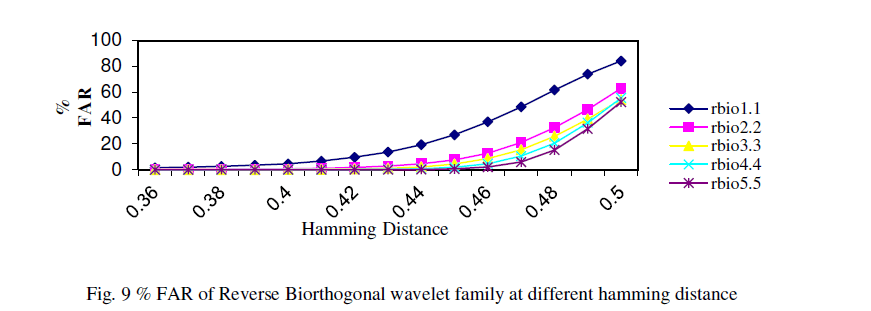 |
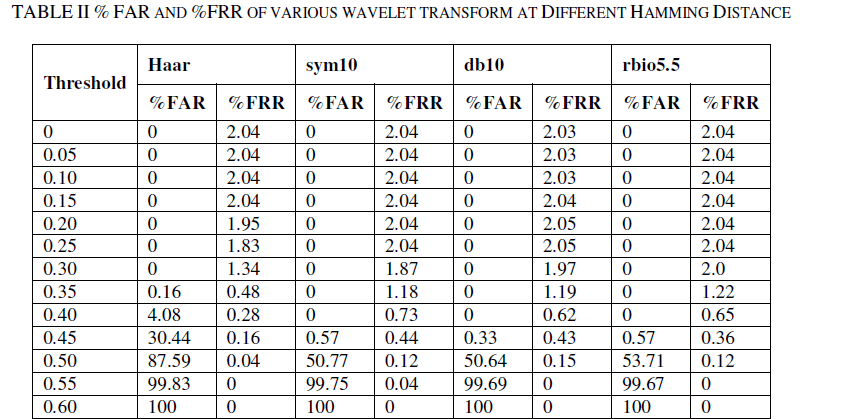 |
| B. Experiment 2 |
| In second experiments, four different eye images of 50 people are used from CASIA V3.0 Lamp iris database. One eye image has been employed for enrolment and remaining three used for testing. Results are achieved with haar, sym10, db10, and rbio5.5 wavelets as these performed better in their families in experiment 1.c |
| % FAR And % FRR of various wavelets at different hamming distance values are indicated in Table II. FRR values were 1.34%, 0.73%, 0.62, and 0.65% using Haar, sym10, db10, and rbio5.5wavelet respectively. FAR=0% is given by all these four wavelets. |
| The Receiver Operating Characteristic (ROC) curve is a False Acceptance Rate (FAR) versus False Rejection Rate (FRR) curve. The ROC curves in figures 10 to 13 represents the ROC results, which also measure the performance of iris matching process. |
 |
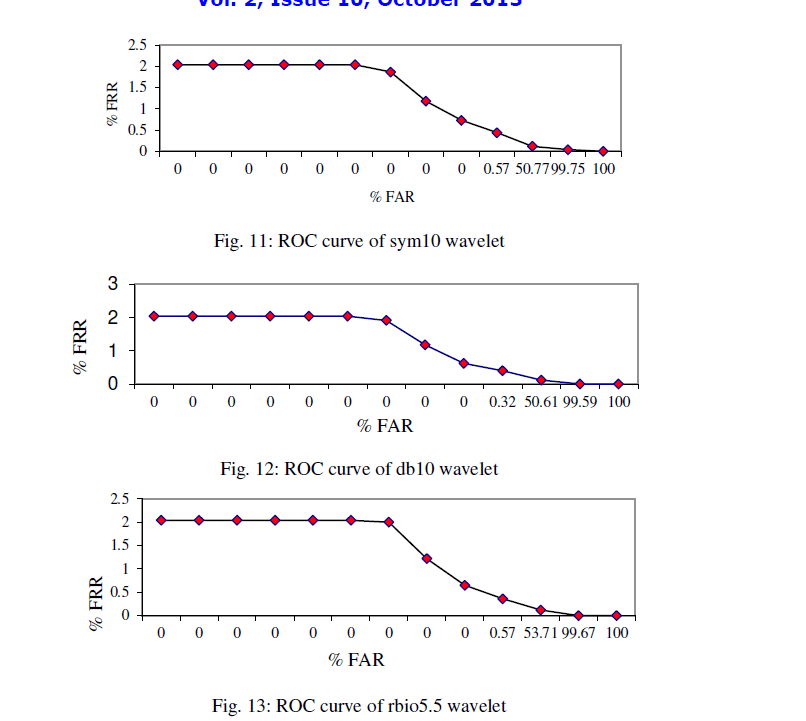 |
CONCLUSION
|
| this paper performance of Haar, Daubechies, Symlet and Reverse Biorthogonal wavelets families are evaluated. Two experiments have been performed to find the optimal performance among all these wavelets in iris authentication system. Results illustrate that db10 wavelet is better for feature extraction because size of feature template is 1216 bits, FAR=0% and FRR=0.62%. Table III gives comparative study of some existing systems in cooperation with the results obtained by the proposed method. Reliable and better and results are achieved by db10 wavelet transform. |
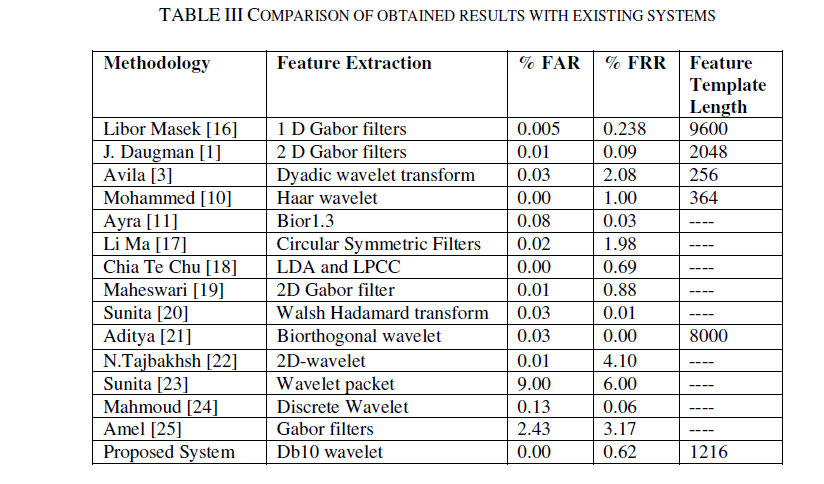 |
References
|
- J. Daugman, “High Confidence visual recognition of person by a test of statistical independence,” IEEE Transaction Pattern Analysis and Machine Intelligence, vol. 15, pp.1148–1161, 1993.
- Jaemin Kim, Seongwon Cho and Jinsu Choi, “Iris recognition using wavelet features,” Journal of VLSI Signal Processing, vol. 38, pp. 147–156, 2004.
- C.Sanchez Avila, R.Sanchez Avila and D. Martin Roche, “Iris based biometric recognition using dyadic wavelet transform,” IEEE AESS Systems Magazine, pp. 3-6, 2002.
- Xiaofu He and Pengfei Shi, “Extraction of complex wavelet features for iris recognition,” Proceeding of the 19th International Conference on Pattern Recognition, pp. 1-4,2008.
- SandipanP.Narote,AbhilashaS.Narote and LaxmanM.Waghmare, “Iris based recognition system using wavelet transform,” International Journal of Computer Science andNetwork Security, vol. 9 no. 11, pp. 101-104, 2009.
- S. Hariprasath and V.Mohan, “Iris pattern recognition using complex wavelet and wavelet packet transform,” Journal of Computer Applications, vol. 2, no.2, pp. 18-23, 2009.
- LeninaVithalraoBirgale and ManeshKokare, “Iris recognition using discrete wavelet transform,” Proceedings of the International Conference on Digital Image Processing,pp. 147-151, 2009.
- Lin Zhonghua, and Ma Hongyan, “Iris recognition method based on the morlet wavelet transform real coefficients,” Proceedings of the International Symposium onInformation Processing, Huangshan, P. R. China, pp. 113-116, 2009.
- SomnathDey and DebasisSamanta, “Improved feature processing for iris biometric authentication system,” International Journal of Electrical, Computer, and SystemsEngineering, vol. 4, no. 2, pp. 127-134, 2010.
- Mohammed A. M. Abdullah, F. H. A. Al-Dulaimi, Waleed Al-Nuaimy and Ali Al-Aataby, “Efficient small template iris recognition system using wavelet transform,”International Journal of Biometrics and Bioinformatics, vol. 5, no. 1, pp. 16-27, 2011.
- Ayra G. Panganiban, Noel B. Linsangan, and Felicito S. Caluyo, “Implementation of wavelet transform-based algorithm for iris recognition system,” International Journal ofInformation and Electronics Engineering, vol. 2, no. 3, pp. 328-332, 2012.
- Rahul M.Nasare, Shashank G Hase and V.N.More, “Iris recognition by complex wavelet transform,” International Journal of Engineering and Innovative Technology, vol. 1,no. 4, pp. 119-123, 2012.
- Center of Biometrics and Security Research, CASIA Iris Image Database, http://www.cbsr.ia.ac.cn/english/Databases.asp cited on 10th July 2009.
- Wavelet tutorial by RobiPolikar, http://users.rowan.edu/~polikar/WAVELETS/WTtutorial.html, cited on 17th July 2009.
- L.Masek, “Recognition of human iris patterns for biometric identification,” Bachelors Thesis, University of Western Australia, 2003.
- R. Wildes, “Iris recognition: an emerging biometric technology,” Proceeding of the IEEE, vol. 85, no. 9, pp. 1348-1363, 1997.
- L. Ma, Tan, Tieniu, Wang and Yunhong, “Iris recognition using circular symmetric filters,” Processing of the 16th International Conference on Pattern Recognition, vol.2, pp.414-417, 2002.
- 1Chia Te Chu and Ching-Han Chen, “High performance iris recognition based on LDA and LPCC,” Proceedings of the 17th IEEE International Conference on Tools withArtificial Intelligence (ICTAI’05), pp. 417-421, 2005.
- Maheswari, P.Anbalagan and T.Priya, “Efficient iris recognition through improvement in iris segmentation algorithm,” ICGSTGVIP Journal, vol. 8, issue 2, pp. 29-35, 2008.
- Sunita V. Dhavale, “Robust iris recognition based on statistical properties of walshhadamard transform domain,” International Journal of Computer Science Issues, vol. 9,issue 1, no. 2, pp.118-123, 2012.
- AdityaAbhyankar,LawrenceHornak and Stephanie Schuckers, “Biorthogonal wavelets based iris recognition,” Proceeding of the SPIE, Biometric Technology for HumanIdentification II, 59; doi:10.1117/12.604212, 2005.
- NimaTajbakhsh, KhashayarMisaghian, and NaghmehMohammadiBandari, “A region-based iris feature extraction method based on 2D wavelet transform,”Bio_ID_MultiComm, LNCS 5707, pp. 301-307, 2009.
- SunitaLokhandeVishram, N. Bapat, “Iris recognition for biometric identification using wavelet packet decomposition,” International Journal of Engineering Research &Technology (IJERT), vol. 1 issue 4, pp.1-7, 2012 .
- Mahmoud Elgamal and Nasser Al-Biqami, “An efficient feature extraction method for iris recognition based on wavelet transformation,” International Journal of Computerand Information Technology, vol. 02, issue 03, pp. 521-527, 2013.
- AmelSaeedTuama (2012), “Iris image segmentation and recognition,” International Journal of Comp Science Emerging Technology, vol. 3, no. 2 pp. 60-65
|